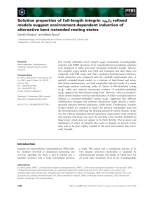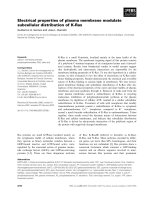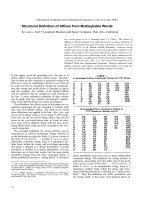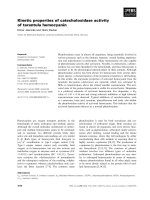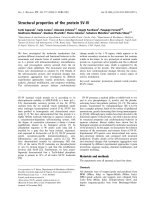Báo cáo khoa học " Antimicrobial properties of shiitake mushrooms (Lentinula edodes) " docx
Bạn đang xem bản rút gọn của tài liệu. Xem và tải ngay bản đầy đủ của tài liệu tại đây (95.15 KB, 2 trang )
International Journal of Antimicrobial Agents 33 (2009) 591–592
Contents lists available at ScienceDirect
International Journal of Antimicrobial Agents
journal homepage: />Letter to the Editor
Antimicrobial properties of shiitake mushrooms (Lentinula
edodes)
Sir,
The shiitake mushroom, Lentinula edodes (Berk.) Sing, is a culi-
nary delicacy and has traditionally been used as medicine in Asia
dating back over 2000 years. Shiitake mushrooms contain pro-
tein, lipids (primarily linoleic acid), carbohydrates, fibre, minerals,
vitamins B1, B2 and C, and ergosterol, the D provitamin [1]. One
of the major compounds isolated from the shiitake mushroom is
lentinan [(C
6
H
10
O
5
)
n
], a polysaccharide with a mean molecular
mass of 500 kDa which acts as an activator for macrophage T-
lymphocytes and other immune effector cells that modulate the
release of cytokines, which in turn may account for i ts indirect
antitumour and antimicrobial properties.
In this study, a known quantity of shiitake freeze-dried pow-
der was suspended in an equal weight/volume of sterile 0.1%
(w/v) peptone saline (PS) (CM0733; Oxoid Ltd., Basingstoke, UK)
and filter-sterilised through a 0.22 m syringe filter (Millipore
(UK) Ltd., Watford, UK) before microbiological challenge. Sterile PS
and antibiotic susceptibility discs containing 5 g of ciprofloxacin
(MAST Diagnostics Ltd., Bootle, UK) were employed as negative and
positive controls, respectively. All test organisms (Table 1) were cul-
tured on Columbia blood agar (CM0331; Oxoid Ltd.) supplemented
with 5% (v/v) defibrinated horse blood and incubated for 24 h at
37
◦
C. Under aseptic conditions, dilutions of each isolate were pre-
Table 1
Organisms tested for positive inhibition by aqueous extracts of freeze-dried shiitake mushrooms (Lentinula edodes).
Organism
a
Source Notes
Paenibacillus lentimorbus, Bacillus licheniformis, Bacillus
subtilis, Pseudomonas mevalonii,
Klebsiella/Enterobacter sp., Sphingobacterium
multivorum, Microbacterium sp., Stenotrophomonas
sp.
Mushroom composts Medically relevant opportunistic infections of patients
Pseudomonas syringae subsp. savastanoi and P. syringae
subsp. phaseolicola (4 UK races, strain nos.:
NCPB-604, 605, 606, 607, 1320, 1321, 2571,1494,
1752, 3613, 4016); Pseudomonas pv. tolasii (2192,
1116, 3148, 387, 741, 1311, 2193, HB101)
Plant and soil sources in crop residues (bacteria present
in aerosolic dusts) (Central Science Laboratory, UK)
Environmentally important, agrienvironment
disseminated (soil/plant dust), can serve as a reservoir
for Pseudomonas opportunistic infections in healthcare
environments
Pseudomonas aeruginosa Plant and soil sources Opportunistic plant and environmental pathogen
Bacillus subtilis, Bacillus cereus, Serratia marcescens,
Serratia spp./Rahnella, Cupriavidus
Seed surfaces and composted fertiliser pellets,
compost wastes
Dormant pathogen of risk to animal and human health
MRSA, Alcaligenes faecalis, Escherichia coli 0157 Environmental pathogens Associated with endogenous opportunistic infections
in immune compromised patients
Fungal isolates
Aspergillus niger, Aspergillus flavus Mushroom composts Isolated at Applied Plant Science Division, Agri-Food &
Biosciences Institute, Belfast, UK
Fusarium graminearum Cereal seeds fungal pathogen Mycotoxins such as deoxynivalenol (Vomitoxin,
ribotoxic) interrupt human and animal immune
modulatory responses
MRSA, meticillin-resistant Staphylococcus aureus.
a
All isolates listed above are from the culture collections of those held at Agri-Food & Biosciences Institute stock.
pared individually in 0.1% PS, equating to a 0.5 McFarland standard
(ca. 10
6
colony-forming units/mL), which was then inoculated onto
Mueller–Hinton agar (CM0337; Oxoid Ltd.) with a sterile cotton
swab, followed by fresh extracts (10 L); the inoculum was allowed
to dry prior to incubation. The plates were examined visually and
any inhibition was noted and its diameter measured and recorded.
Bioassay of the extracts showed that all the fractions exhibited
qualitative inhibitory activity against all bacteria and fungi tested.
Prompted in part by the response to opportunistic pathogens, a
number of these metabolites or their aqueous extracts are currently
being tested for their efficacy against a range of human clinical
pathogens.
As a result of the demonstration of its antibacterial and antifun-
gal activity, we subsequently attempted to identify the chemical
components of the shiitake from extracts and have provision-
ally identified 34 compounds whose structure assignments were
based largely on the interpretations surrounding mass spectral
(MS) data deduced from previously reported metabolites. We
have identified a number of new antimicrobial metabolites not
previously identified in shiitake mushrooms. These include cyclo-
heximide (an antibiotic substance that acts as a plant growth
regulator, butcauses human liver toxicity and a reduction in protein
synthesis), bostrycoidin (bioactive in vitro against Mycobacterium
tuberculosis), anticarcinogenic alkaloids (muscarine, choline), tan-
nins (epiafzelechin) and terpenoids (adiantone), cyclopiazonic acid
(a natural food contaminant) and aspergillomarasmine. The lower
0924-8579/$ – see front matter © 2008 Elsevier B.V. and the International Society of Chemotherapy. All rights reserved.
doi:10.1016/j.ijantimicag.2008.10.018
592 Letter to the Editor / International Journal of Antimicrobial Agents 33 (2009) 591–592
level of activity of polar compounds in water-soluble extracts
(Fraction 3) indicated that the antibacterial properties of shiitake
mushrooms may have arisen largely from less polar organic com-
pounds and the data also suggest that the higher activity may be
due to the presence of disulphides, lenthionine compounds in the
organic extracts. The aqueous extracts also confirmed the pres-
ence of eritadenine and a metabolite with a molecular weight
of 237 (C
15
H
11
NO
2
), possibly a derivative of viridicatine, together
with gallic acid (deduced from the ion peaks accompanying the
MS data (M
+
H)
+
171.2 with molecular weight 170). Gallic acid has
been shown to have antibacterial properties and also exerts anticar-
cinogenic activity on cancerous cells in animals. The presence of a
tannin precursor provides the basis for epiafzelechin, with a molec-
ular weight of 274, and the presence of a fungal metabolite with a
molecular weight of 285, bostrycoidin (C
15
H
11
NO
5
), was also estab-
lished via GC–MS methods. Bostrycoidin is an antibiotic substance
and has been shown to be active in vitro against M. tuberculosis.
A number of other metabolites that were previously only obtained
via organic solvent extractions are also reported in our freeze-dried
aqueous extracts and include eritadenine, deoxyeritadenine, cyclo-
heximide, 1,2,4,6-tetrathiepane, muscarine, choline and the sterol
C
28
H
44
O
6
, and a fungal metabolite usually found in other mush-
rooms’ cycloheximide (MW 281), found in the ethyl acetate-soluble
portion of the methanol extract and in the methanol-soluble por-
tion of the freeze-dried extract in our studies. It is beyond the
scope of this current report to evaluate the quantitative yield for
all the reported metabolites at present as well as how they com-
pare with other mushrooms. It is expected that the occurrence
of some of these metabolites may be in much smaller quantities
in the shiitake mushroom than in others. However, this can be
regarded as an advantage as they may not impose toxic side effects
but none the less may be sufficient to express antibiosis, an ideal
scenario for a natural medicinal product. Although other recent
studies examining the presence of antimicrobial components in
native plant varieties of the British Isles was unable to demonstrate
any antibacterial or antifungal properties [2], with the exception of
garlic (Allium sativum), the current study is encouraging and high-
lights a potent antimicrobial fungus, which now requires further
investigation and scientific follow-up.
Acknowledgments
The authors wish to acknowledge David Nelson and Graham
McCollum for their help with this work. They also thank the Agri-
Food & Biosciences Institute (AFBI), the University of Ulster and
the Nuffield Foundation for their support and assistance in this
research.
Funding: JEM was partly supported by a Department of Health
and Social Services and Public Safety (DHSSPS) Research Develop-
ment Office grant (RRG 9.9), Belfast, UK.
Competing interests: None declared.
Ethical approval: Not required.
References
[1] Zuccato E, Calamari D, Natangelo M, Fanelli R. Presence of therapeutic drugs in
the environment. Lancet 2000;335:1789–90.
[2] Woods-Panzaru S, Nelson D, McCollum G, Ballard L, Millar BC, Maeda Y, et
al. An examination of antibacterial and antifungal properties of constituents
described in traditional Ulster cures and remedies. Ulster Med J 2009;78:
1–3.
Juluri R. Rao
a
B. Cherie Millar
b
John E. Moore
b,c,∗
a
Environmental Pathology, Applied Plant Science
Division, Agri-Food & Biosciences Institute, Newforge Lane,
Belfast BT9 5PX, UK
b
Northern Ireland Public Health Laboratory, Department of
Bacteriology, Belfast City Hospital, Lisburn Road,
Belfast BT9 7AD, UK
c
School of Biomedical Sciences, Centre for Molecular Biosciences,
University of Ulster, Cromore Road, Coleraine, Co. Londonderry
BT52 1SA, UK
∗
Corresponding author. Tel.: +44 28 9026 3554;
fax: +44 28 9026 3991.
E-mail address: (J.E. Moore)
16 October 2008
